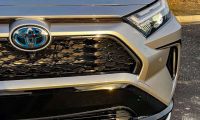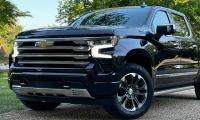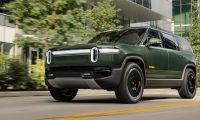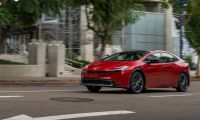As our deep dive story into the Toyota RAV4 Prime explained last week, the new RAV4 PHEV launched with a volume and delivery rate almost unmatched in green vehicle history. The team at Toyota delivered about 1,000 RAV4 Primes to American owners in the first two months of its first sale. That rate is dramatically faster than the Tesla Model 3, Tesla Model X, Tesla Model S, and outpaced vehicles like the Bolt, Outlander PHEV, and Leaf. Even more impressively, it happened during the pandemic slowdown period.

Now that the 2021 Toyota RAV4 Prime is for sale in the United States, customers are eagerly seeking out the plug-in hybrid-electric crossover. Dealers in some areas, particularly in California, are even selling the RAV4 Prime at above MSRP. That is unusual for a Toyota model, and almost unheard of for a family crossover. The high prices and motivated shoppers are a strong indication that this model could well become the top-selling affordable electric vehicle in the U.S. market. Could become.
Tesla Model 3 Path
The Tesla Model 3’s launch was a fiasco. Tesla overstated how quickly the Model 3 would come to market, and then production SNAFUs at Tesla meant that it took Tesla five months to sell the first 1,000 units. However, Tesla remained committed to the product, survived being “near death” to use Elon Musk’s words, and the Model 3 became the second-largest green vehicle success story in history after the Prius.
Tesla didn’t limit its Model 3 to a volume that would qualify for tax benefits, didn’t continue to restrict it to only those states that bribe buyers with EV incentives, and never looked at the Model 3 as a compliance car. It was instead, a car that Tesla wanted to build in the highest-possible volumes in the shortest possible time. Today, the Model 3 remains a success heading into its fourth year of sales.
Related Story: Tesla Model 3 Outsells Every Car Model At BMW, Lexus - Outsells All of Audi and Acura
Honda Clarity PHEV Path
Honda’s Clarity PHEV is another electric vehicle that was a smash-hit with buyers. The Clarity was also sought-after by shoppers and it also became a top-seller. The Honda Clarity became the top-selling affordable EV in America two years ago in October 2018. The Clarity passed the Prius Prime, Chevy Bolt, and Chevy Bolt and had a run rate of over 2,000 units per month. Fan clubs on Facebook sprung up. Honda fans joined Chevy Volt fans in discovering that PHEVs like the Clarity can be operated as primarily electric vehicles, but without ever having to worry about finding a place to charge in a pinch. The future looked very bright for Honda electrified vehicle fans.
And then Honda pulled the plug. Instead of doubling-down on production of a hit vehicle, Honda instead decided to restrict the Clarity PHEV’s inventory allotments to just Californian dealers. After once being the top-seller among all affordable EVS, the Honda sold just 354 Clarity cars this past month.
Related Story: Honda Pulls Back 2019 Clarity PHEV & Chevy Kills Volt EREV - Tell Us Your Theories As To Why Popular EVs are Going Away
Toyota RAV4 Prime Production Volume For U.S.
As the automotive manufacturing world struggles with peak battery supply, Toyota has been careful not to move too quickly into battery-electric vehicle production. Just like GM, Ford, and every other manufacturer, except Tesla, who has no choice since they only build BEVs. Toyota was the world’s first automaker to create an all-electric crossover, and had two prior BEV RAV4 generations before making the wise decision to adopt PHEV technology for this new generation. Despite this, Toyota indicated in June of this year that battery constraints would still limit the RAV4 Prime’s availability.
Electric vehicle tax benefits are also in flux. A U.S. Presidential and Congressional election cycle means that the future of tax-payer supported federal tax incentives for EVs is unclear. This makes Toyota’s planning harder. Would the RAV4 Prime succeed without its $7,500 cost advantage from the American tax code?
The electric vehicle’s modern age is now into its second decade. Every automaker has electrified vehicles now. Every automaker knows the ground rules, knows what should and should not work in the marketplace and at what price point. As the global leader in green vehicle sales, Toyota knows these things better than any other automaker. Heading into Q4 of this year and 2021 beyond, Toyota has come to a crossroads. Green vehicle fans and consumers just want to know one thing; Will the Toyota RAV4 Prime follow the Tesla Model 3’s path to success, or the Honda Clarity’s path to obscurity? Feel free to make your prediction in the comments section below.
John Goreham is a long-time New England Motor Press Association member and recovering engineer. Following his engineering program, John also completed a marketing program at Northeastern University and worked with automotive component manufacturers. In addition to Torque News, John's work has appeared in print in dozens of American newspapers and he provides reviews to many vehicle shopping sites. You can follow John on Twitter, and view his credentials at Linkedin
Hover mouse over image to see photo credits













Comments
I think that Toyota RAV4
Permalink
I think that Toyota RAV4 Prime has a good chance of out-selling Tesla for some years now. The 2020s will be the decade of PHEVs, in my forecast, as people slowly adjust to the idea of plugs in cars and SUVs and trucks, as attractive PHEVs with good all-electric range come on the market at affordable prices. The 2030s will see a gradual move from PHEVs to BEVs as charging infrastructure improves and costs come down on battery production and mileage ranges increase dramatically. I think that the RAV4 Prime will go down in history has one of the most significant models in automobile history, because it's Toyota's biggest seller and Toyota is the world's largest automaker; this is seismic. Toyota has the power to change how consumers and drivers buy and think, having done so well with the RAV4 Prime with its 40-50 miles of all-electric range and packing an 18-kWh battery pack in as they have done. A range of only 20-30 miles would not have done so much, frankly, which is why most other PHEVs have not fared well. ICEVs are so 20th-century; China and Europe, and many in the USA, will ensure that the road to non-gasoline-powered vehicles will continue forward, even if gradually.
I own a Prius V hybrid. I
Permalink
I own a Prius V hybrid. I love the car however I want to replace it in 2 to 4 years and the Rav 4 PHEV would be my choice if I can get one here in Canada! I certainly hope Toyota has them in sufficient quantities by then! If not I will likely look at other PHEV's I only have one vehicle so a BEV probably will not work for me as I travel 30000km at least yearly and long trips across the country once or twice. I have no stomach for stopping every 400km to charge a vehicle for 30 plus minutes or worse!
The RAV4 Prime will sell
Permalink
The RAV4 Prime will sell without rebates. It's still a good bargain given the additional EV range. The difference is it may not be in such high demand with several months before it will become truly available.